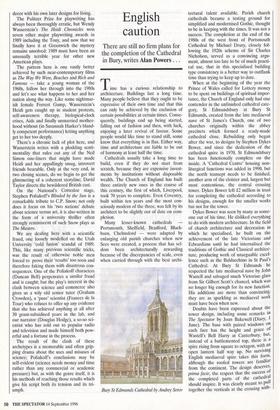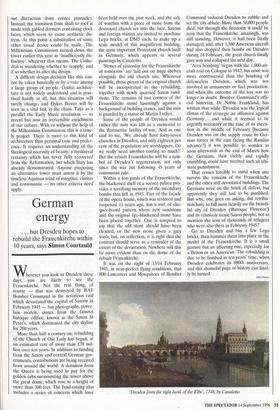English caution
There are still no firm plans for the completion of the Cathedral in Bury, writes Alan Powers .
Time has a curious relationship to architecture. Buildings last a long time. Many people believe that they ought to be expressive of their own time and that this can only be achieved by the exclusion of certain possibilities at certain times. Conse- quently, buildings end up being started, falling out of fashion and then, with luck, enjoying a later revival of favour. Some people would like time to stand still, some know that everything is in flux. Either way, time and architecture are liable to be out of harmony at least half the time.
Cathedrals usually take a long time to build, even if they do not start from scratch, because they are expensive invest- ments by institutions without disposable wealth. The Church of England has built three entirely new ones in the course of this century, the first of which, Liverpool, took 70 years to complete. Even Coventry, built within ten years and the most con- sciously modern of the three, was felt by its architect to be slightly out of date on com- pletion.
Many lesser-known cathedrals Portsmouth, Sheffield, Bradford, Black- burn, Chelmsford — were adapted by enlarging old parish churches when new Sees were created, a process that has sel- dom been architecturally rewarding because of the discrepancies of scale, even when carried through with the best archi-
Bury St Edmunds Cathedral by Andrey Serov tectural talent available. Parish church cathedrals became a testing ground for simplified and modernised Gothic, thought to be in keeping with the times. It was not a success. The completion at the end of the 1980s of the west front of Portsmouth Cathedral by Michael Drury, closely fol- lowing the 1920s scheme of Sir Charles Nicholson, served as a convincing argu- ment, almost too late to be of much practi- cal use, that in this specialised building type consistency is a better way to outflank time than trying to keep up to date.
When at the beginning of the year the Prince of Wales called for Lottery money to be spent on buildings of spiritual impor- tance, the Church of England only had one contender in the unfinished cathedral cate- gory, St Edmundsbury at Bury St Edmunds, created from the late mediaeval nave of St James's Church, one of two churches originally within the abbey precincts which formed a ready-made cathedral close. Rebuilding only began after the war, to designs by Stephen Dykes Bower, and since the dedication of the cathedral quire in 1970, St Edmundsbury has been functionally complete on the inside. A 'Cathedral Centre' housing non- liturgical functions was added in 1990, but the north transept needs to be fmished, another arm of the cloister and, largest but most contentious, the central crossing tower. Dykes Bower left £2 million in trust for completing the cathedral according to his designs, enough for the smaller works but not for the tower.
Dykes Bower was seen by many as some- one out of his time. He disliked everything to do with modern architecture. In the field of church architecture and decoration in which he specialised, he built on the achievement of the late Victorians and Edwardians until he had internalised the traditions of Gothic and Classical architec- ture, producing work of unarguable excel- lence such as the Baldacchino in St Paul's Cathedral. At Bury St Edmunds he respected the late mediaeval nave by John Wastell and salvaged much Victorian glass from Sir Gilbert Scott's chancel, which was no longer big enough for its new function. His additions are more than convincing, they are as sparkling as mediaeval work must have been when new.
Doubts have been expressed about the tower design, including some remarks in The Spectator by Joan Bakewell (Diary, 1 June). The base with paired windows on each face has the height and grace of Wastell's Bell Harry at Canterbury, but, instead of a battlemented top, there is a spire rising from square to octagon, with an open lantern half way up. No surviving English mediaeval spire takes this form, although the roofed towers are familiar from the continent. The design deserves, prima facie, the respect that the success of the completed parts of the cathedral should inspire. It was clearly meant to pull together the verticals at the crossing with-
out distraction from corner pinnacles. Instead, the transition from shaft to roof is made with gabled dormers containing clock faces, which seem to cause aesthetic dis- tress. At this point a substitution of some other visual device could be made. The Millennium Commission turned down the tower earlier this year as 'insufficiently dis- tinctive', whatever that means. The Cathe- dral is wondering whether to reapply, and if so whether to alter the design.
A difficult design decision like this can- not be taken hurriedly or by a vote among a large group of people. Gothic architec- ture is not widely understood and is prac- tised hardly at all, but this situation will surely change, and Dykes Bower will be seen as a vital link in the chain. Take as a parallel the Early Music revolution — so recent but now an irreversible enrichment of our culture. With or without the help of the Millennium Commission, this is a time- ly project. There is more to this kind of architecture than personal taste and prefer- ence. It requires an understanding of the theological necessity of beauty, a mediaeval certainty which has never fully recovered from the Reformation, but which Bury has already demonstrated. Anyone proposing an alternative tower must assess it by the timeless Aquinan triad of integritas, claritas and consonantia — no other criteria need apply.



































































 Previous page
Previous page